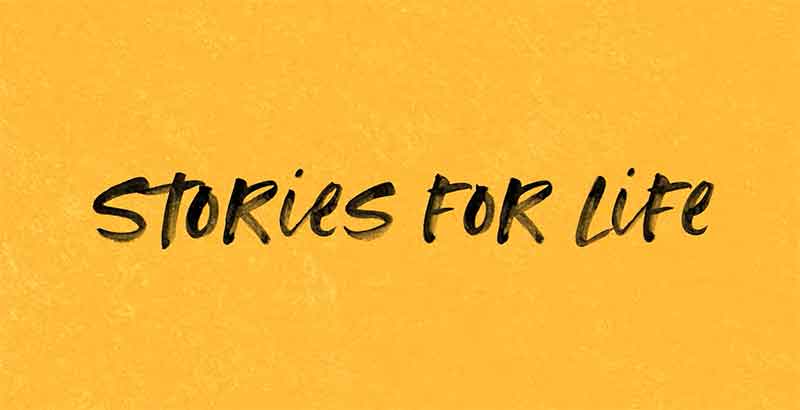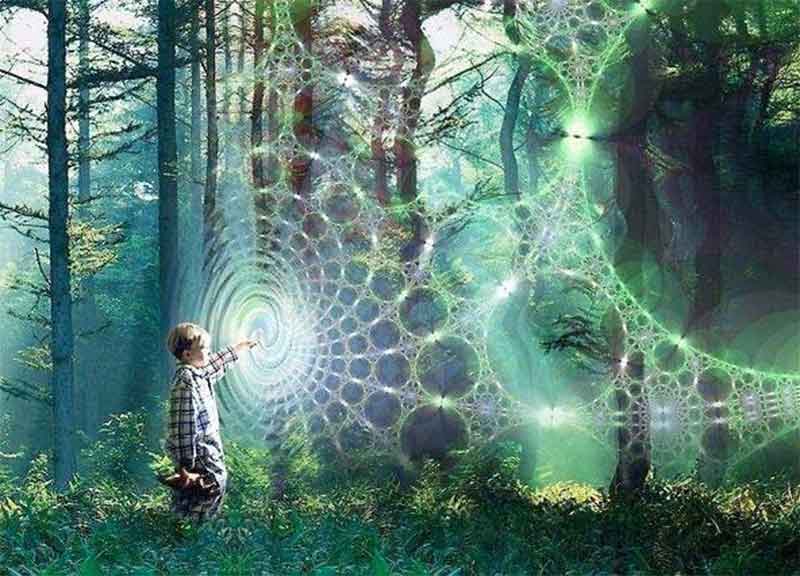A short film and narratives project “Stories for Life” seeks to bring about the shift in culture that humanity needs to survive.

The stories we do and don’t tell about ourselves and these times in which we’re living shape the direction of our lives and our cultures. Stories have the power to alter how we interact and relate. Those who study cultural anthropology and the origins of humanity are finding that cultural stories—the things people collectively believe about ourselves and our capacities—have forever shaped human societies, going back to our early hominid ancestors. In shifting those narratives now, they argue, we have the realistic potential to evolve on purpose as a species. Given the dire, multifront crises of our times—from climate disaster to war to poverty—this kind of cultural and social evolution is desperately needed.
An animated short film, which screened between acts on the big screens of each of the four main stages at the Glastonbury Music Festival in 2022, delves into the idea of story as a means for change. It is titled, “Stories for Life,” and it opens with scenes of fire, a child digging through a pile of trash, plastic rubbage floating in the water, and smoke billowing from an industrial tower. A narrator’s voice speaks over the imagery: “Life is in trouble. As a species, we are facing multiple crises that we can no longer ignore. At the root of them all is our economy; an economy designed to destroy life; an economy designed by us.”
As the narration continues, a series of illustrated signs seem to lay out the challenges of our world, one by one: “Capitalism is crashing. Society is dividing. Democracy is degrading. Climate is tipping. Ecology is vanishing. Disease is spreading. Inequity is rising. Protest is pervading.”
The film takes viewers through a brief history of humanity’s relationship with the Earth. It delves into the problems of our current ways of living, then offers the potential to rewrite the story of our values, and begin to create livable systems in which value is based on the well-being of all life.
Over animations of cave paintings, constellations, and wildlife, the film reminds viewers that “our ancestors lived in intimate relationship with the more-than-human world” and told stories about, “nature as our family, our guardian, our guide. But then some of… [our ancestors] imagined and created ways to control the natural world. This made them feel more powerful and superior to nature. Separate from it. The more powerful they felt the more disconnected from nature they became. And so they began to tell new stories. Stories that normalized domination, control, and the oppression of life. About how nature is our slave, there to be captured and exploited. They began to scorch, spoil, and suffocate our world. And as they did so, these stories spread, and became common sense.”
This narration comes with animations of the industrialization and commodification of resources: factories, men in suits and wigs, ships with cargo. The film goes on to explain that such stories have led people down the path of greed, grand, hustle, and blind progress, and made people “feel separate, not only from nature but from each other, in constant competition and conflict.”
Horror Stories, Love Stories
The narrator notes that these stories then became horror stories of ruined lives and a ruined world, as images of refugee camps, rubbage heaps, and melting ice caps show on screen. “But, it doesn’t have to go on like this,” the narrator says. “We can choose to live by different stories: Love stories about interconnection and interdependence. Love stories that measure success by well-being—the well-being of all life including our own. Love stories about interconnection and interdependence.” Now, the scene is blooming flowers, mycelial networks, collaborative groups of people, and brightly colored animal life.
The film outlines how these “love stories” will lead us to reconnection, so that we can regenerate our relationships with nature and each other, and create a steam that nourishes and supports the life we all want to live rather than destroying life. It closes with the reminder that “we all have the power to tell these stories,” and that many people are already doing so.
The concept behind the film is part of a larger website project launched in 2020, also called Stories for Life, aimed at highlighting stories that support ways forward for humanity and all life. It began as a collaboration between the Green Economy Coalition, Wellbeing Economy Alliance, and the Spaceship Earth, and as its website states: “This project was inspired by the question ‘how do we tell the story of a new economy?’”
The eventual Stories for Life project was co-created by Dan Burgess and Paddy Loughman with the purpose of helping to “create stories that contribute to the re-design of a healthier economy. To bring forth new and ancient stories into our culture, which weave a narrative of interconnection and help us design a new type of economy,” as notes the Stories for Life website.
Co-creator Dan Burgess—a writer, podcast host, and learning guide—says his work centers on supporting the growth of regenerative cultures and creative activism, all aimed at cultural shifts that may “help people remember we are part of a living Earth.” He says in addition to himself and Loughman, there have been many collaborators and supporters, and that Stories for Life’s creators ultimately wanted to help make more readily accessible and clear “the relationship between everyday stories and how they shape cultural narratives, and how those things shape the design of human systems—in this case, the economic system,” he says. “We wanted to help more people understand that and see that in these times, stories are very powerful and we’re all carrying them. So in that sense we all have the ability to make an impact.”
He adds that another aim was to weave together thinking around how cultural stories are currently shaping westernized economic systems, and the destruction those systems are responsible for.
“What we were trying to do [from the outset] is explore the role of stories in either maintaining and perpetuating these destructive economic designs,” he says.
Stories for Life eventually published eight chapters, each referencing the stories of many people. As the Overview chapter states, “There is a better narrative. A healthier narrative that has been carried by cultures around the world for thousands of years, and is now being recognised by the latest scientific breakthroughs. A narrative grounded in the recognition that we are all entangled, integrated, dependent on each other and the more-than-human world around us.”
Burgess shares that the Stories for Life film and concept are being shared by a number of groups and organizations around the world, as a means of inspiration and provocation.
“Our Indigenous brothers and sisters have always known what our ancestors knew, and what modern science now tells us is true: that we are all entangled and wrapped up with life,” he says, adding that Stories for Life was an opportunity to bring together a lifetime of experiences and learning, in a package that seeks to make these concepts more accessible.
Learning Journeys
Burgess suggests the Stories For Life project is a way of giving permission to people to explore new ways of looking at our world—himself included. On his podcast, the Spaceship Earth podcast, which started in 2018, he began to offer what he calls peer-supported learning journeys, for creative activists and regenerative change-makers.
“It’s a kind of action learning,” he says. “We work as a group and we explore, quite deeply, our connection with the natural world. We support each other to cultivate our creative courage to start to point our creative energies at trying to offer something to these times which is going to slow down the destruction of our living Earth and start to bring people back together.”
Out of this exploration, a collaboration between Stories for Life and Burgess’s learning platform, Becoming Crew, launched a three-month learning journey offering in 2023, for people looking to work with stories in this way.
“It’s this idea of becoming crew on Spaceship Earth, like stepping up in service and becoming active participants in the changes we need,” he says. The learning journey brought together a group of 40 different practitioners from nine countries who work with concepts of story and narrative in our culture, who had been on the podcast.
“We deeply explored some of the Stories for Life work, building practices to help people explore the natural world around them in much more intimate, relational ways—and use that re-entanglement with nature as a way of exploring their creativity, and how stories are evolving for them.”
He says there are two major story themes that Stories for Life is working to shift. One centers on how people can, at the micro and macro levels, steer the stories of our relationship to the natural world away from those that frame it as a commodity resource that is separate from ourselves.
“There are millions of stories every day that people are working with, which keep perpetuating that view of the living world as resource,” he says. “You’ve only got to look at the pollution of the oceans, rivers, the air we’re breathing—the toxicity: We treat the living world as a slave to human progress.”
The other major theme with which Stories for Life is working involves shifting people’s conceptions of what is realistic and possible.
“Can we help people imagine a world where we’ve shifted the dominant story of how we measure success away from productivity, accumulation, and growth to a story of the well-being of all life?” he asks. This is a reframing of value, which measures success by the health and well-being of fellow humans and the ecosystems we are a part of.
Burgess says Stories for Life’s narratives are a way of birthing and seeding new stories that may “bring us back together and help people recognize that we’re entangled with all life… and begin to see cultural stories that completely help us, reframe what success is all about in this culture, what it is to be human, what is our relationship with the natural world.”
April M. Short is an editor, journalist, and documentary editor and producer. She is a co-founder of the Observatory, where she is the Local Peace Economy editor, and she is a writing fellow at the Independent Media Institute. Previously, she was a managing editor at AlterNet as well as an award-winning senior staff writer for Good Times, a weekly newspaper in Santa Cruz, California. Her work has been published with the San Francisco Chronicle, In These Times, LA Yoga, the Conversation, Salon, and many other publications.
This article was produced by Local Peace Economy.















































